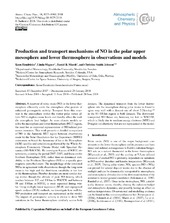| dc.contributor.author | Hendrickx, Koen | |
| dc.contributor.author | Megner, Linda | |
| dc.contributor.author | Marsh, Daniel R. | |
| dc.contributor.author | Smith-Johnsen, Christine | |
| dc.date.accessioned | 2019-05-28T08:55:59Z | |
| dc.date.available | 2019-05-28T08:55:59Z | |
| dc.date.issued | 2018-06-28 | |
| dc.Published | Hendrickx K, Megner L, Marsh DR, Smith-Johnsen C. Production and transport mechanisms of NO in the polar upper mesosphere and lower thermosphere in observations and models. Atmospheric Chemistry and Physics. 2018;18:9075-9089 | eng |
| dc.identifier.issn | 1680-7324 | en_US |
| dc.identifier.issn | 1680-7316 | en_US |
| dc.identifier.uri | https://hdl.handle.net/1956/19757 | |
| dc.description.abstract | A reservoir of nitric oxide (NO) in the lower thermosphere efficiently cools the atmosphere after periods of enhanced geomagnetic activity. Transport from this reservoir to the stratosphere within the winter polar vortex allows NO to deplete ozone levels and thereby affect the middle atmospheric heat budget. As more climate models resolve the mesosphere and lower thermosphere (MLT) region, the need for an improved representation of NO-related processes increases. This work presents a detailed comparison of NO in the Antarctic MLT region between observations made by the Solar Occultation for Ice Experiment (SOFIE) instrument on-board the Aeronomy of Ice in the Mesosphere (AIM) satellite and simulations performed by the Whole Atmosphere Community Climate Model with Specified Dynamics (SD-WACCM). We investigate 8 years of SOFIE observations, covering the period 2007–2015, and focus on the Southern Hemisphere (SH), rather than on dynamical variability in the Northern Hemisphere (NH) or a specific geomagnetic perturbed event. The morphology of the simulated NO is in agreement with observations though the long-term mean is too high and the short-term variability is too low in the thermosphere. Number densities are more similar during winter, though the altitude of peak NO density, which reaches between 102 and 106 km in WACCM and between 98 and 104 km in SOFIE, is most separated during winter. Using multiple linear regression (MLR) and superposed epoch analysis (SEA) methods, we investigate how well the NO production and transport are represented in the model. The impact of geomagnetic activity is shown to drive NO variations in the lower thermosphere similarly across both datasets. The dynamical transport from the lower thermosphere into the mesosphere during polar winter is found to agree very well with a descent rate of about 2.2 km day−1 in the 80–110 km region in both datasets. The downward-transported NO fluxes are, however, too low in WACCM, which is likely due to medium energy electrons (MEE) and D-region ion chemistry that are not represented in the model. | en_US |
| dc.language.iso | eng | eng |
| dc.publisher | Copernicus Publications | en_US |
| dc.rights | Attribution CC BY | eng |
| dc.rights.uri | http://creativecommons.org/licenses/by/4.0 | eng |
| dc.title | Production and transport mechanisms of NO in the polar upper mesosphere and lower thermosphere in observations and models | en_US |
| dc.type | Peer reviewed | |
| dc.type | Journal article | |
| dc.date.updated | 2019-01-17T09:47:59Z | |
| dc.description.version | publishedVersion | en_US |
| dc.rights.holder | Copyright 2018 The Author(s) | en_US |
| dc.identifier.doi | https://doi.org/10.5194/acp-18-9075-2018 | |
| dc.identifier.cristin | 1600341 | |
| dc.source.journal | Atmospheric Chemistry and Physics | |

